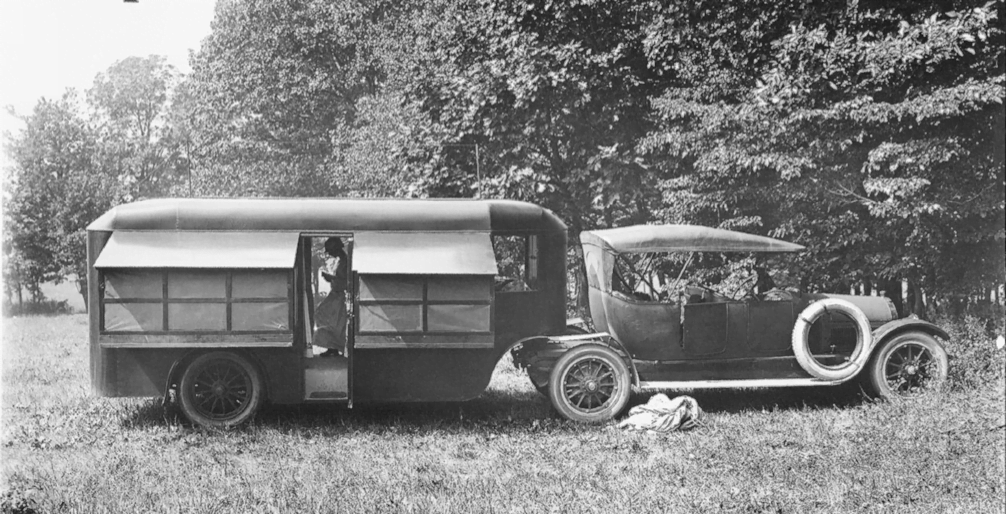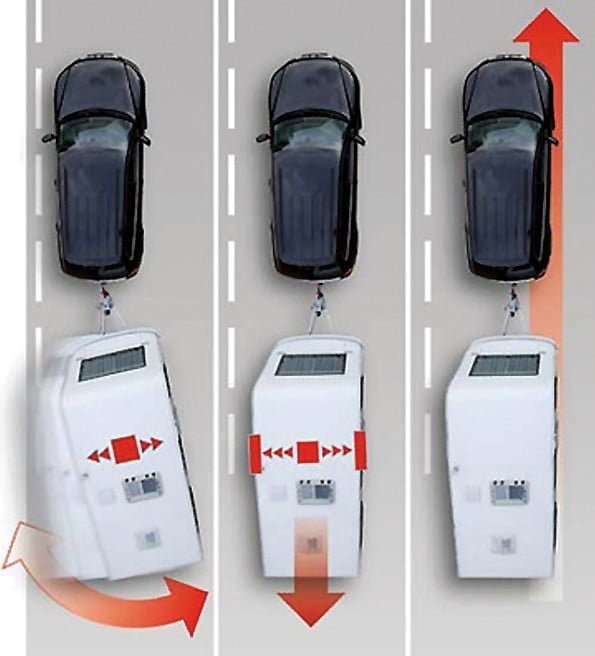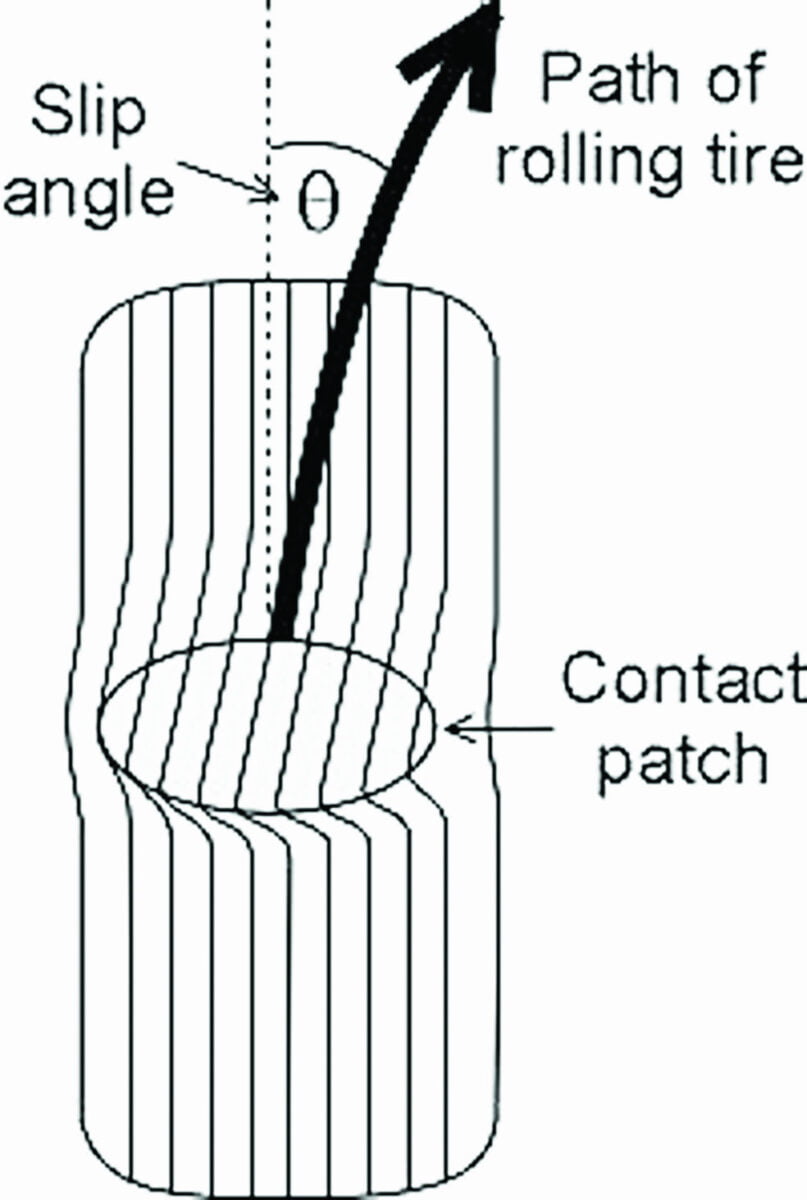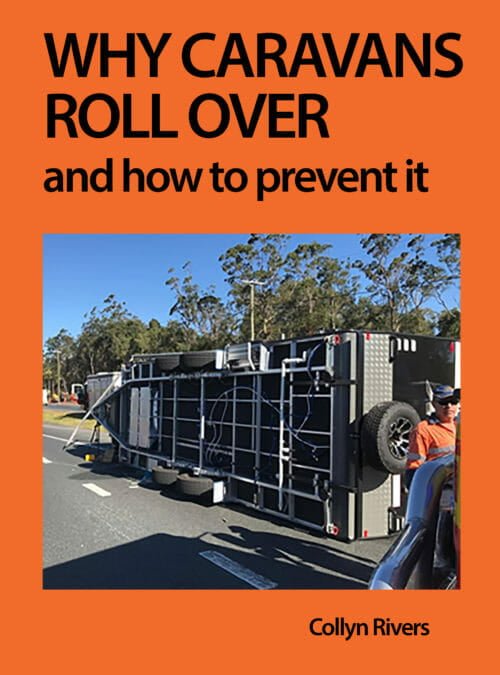by Collyn Rivers
Trailer Dynamics
That caravans roll-over yet most vehicles don’t show trailer dynamics is not understood or is ignored. Trailer dynamics simply explained tells why. The main cause is that hitch extending from the tow vehicle’s rear. It not only allows but causes both tow vehicle and caravan to sway (yaw). Worse – if one yaw’s clockwise it causes the other to sway anti-clockwise. The further the tow ball behind the tow vehicle’s rear axle, the greater that effect.

As a caravan sways, the tow vehicle is caused (by that hitch) to yaw in the opposite direction. Pic: copyright 2014 https://rvbooks.com.au
At low levels, this yaw usually dies out after two or three swings. It’s annoying but harmless. With some rigs, however, it may build up more and more. If this happens above a critical speed (specific to each rig) it may result in jack-knifing, and furthermore – a roll-over. In 2018 one of Australia’s five caravan insurers (alone) reported over 135.

A sad ending. Pic: source unknown.)
Why Caravans Roll Over
This problem, and its main cause, was first known in 1914. Trucks back towed overhung hitched trailers – that subsequently rolled over. The cause (that overhung hitch) was quickly recognised. By 1920 most commercial trailers had the hitch directly over the tow vehicle’s rear axle/s. Most still do.

With no overhang, the trailer pivots around its hitch. It barely affects the tow vehicle. Pic: copyright https://rvbooks.com.au.

Early (about 1917) fifth-wheeler Adams Motor Bungalow. Pic: Glenn H Curtiss Museum (USA).
The inherently more stable fifth-wheeler caravans stem from this era (1912-1920).
As caravans yawed (and worse), people devised ways of preventing it. But they did not address the known causes. On the contrary – they invented various (patentable) add-ons intended to dampen yaw. Still used to this day, they reduce low-speed discomfort. They cannot, however, cope with major yaw forces that may result in rollovers. This is particularly with mainly long and heavy caravans. The reason is that most are frictional devices. Whilst effective at low speeds, the friction remains constant. Sway forces, however, increase with the of rigs speed. At 100 km/h, friction sway devices are only about 1% effective.
Europe’s caravan makers accept the causes: they keep caravan weight low. Their towing laws ensure caravans are about 20% lighter than whatever tows them. Safety is further helped by the general EU 80 km/h towing limit.
The Australian and US approach retain those add-ons, plus a so-called Weight Distributing Hitch. There are also effective electronic stability aids.
Mass, weight and inertia
For an explanation of trailer dynamics, a few technical terms have to be used. The major ones are weight and mass.
Whilst not an issue with things like cooking, weight and mass are different. With caravans and their tow vehicles, that difference is vital.
Mass is a measure of the amount of material in something. It remains exactly the same no matter where it is (including in space).
Weight is the effect gravity has on mass whilst on Earth. It pulls mass downward and that force is regarded and measured as ‘weight’. A given mass actually weighs less on a mountain top.
In space, a mass that weighs 10 kg (22 lb) on Earth has no weight. But if thrown that mass acts as if on Earth. It weighs nothing. But its thrown mass is still equivalent to a 10 kg (22 lb) weight.
For weighing stationary caravans and tow vehicles, mass and weight are the same. But once moving, mass attempts to follow a straight line. This only changes when an equal and opposite force deflects, slows or stops it. This effect is called inertia. (As with politicians, inertia resists change.)
Tow ball mass
Like thrown billiard cues, to keep straight caravans must be front-heavy. Caravan makers and owners have long seen about 10% of the caravan weight is sufficient. In reality, however, short centre-heavy caravans are fine with less. At a typical four metres or so, camper trailers’ tow ball weights vary from 3%-22.5%. It is rare to find one that is unstable.
Many caravan makers, however, now quote tow ball weight as that unladen. And with water tanks empty. Few now recommend laden nose weight, possibly because 10% can no longer be borne by many current tow vehicles. And the trend is to yet less.

Pic: https://rvbooks.com.au
As with a see-saw, the effect of weight depends on where it is relative to its pivot (here the axle). A, B and C (plus and minus) are all one metre apart. +D is half a metre from +C. A weight of 100 kg (220 lb) at +C and -C has an ‘effective weight’ (mass) twice that at +/-B. At +D it is two and a half times that at +B.
The above is a very short (4.0 metre/13 foot) caravan. Were it 7.5 metres the effect of weight (mass) at the tow ball is about 300 kg (660 lb) for every 100 kg (220 lb) there. Despite that many caravans have twin gas cylinders and batteries so located. Plus two spare wheels and even a tool-box at the far rear.
The effect of mass and where it is located matters when a caravan pitches or yaws. The weights’ forces (mass) then increase not only by their distance from the axle/s. They increase while pitching and/or yawing.

The effect of weight along the length of a caravan. Concept and Pic: rvbooks.com.au
With the weight central the bar swings and stops with ease. Moving that same weight outward the bar causes the bar to be increasingly hard to swing. And to stop swinging. The same thing happens if you simulate pitching. Also, the faster you move the bar, the harder it becomes. Caravans behave like this!
Weight distributing hitches
tow ball weight on an overhung hitch acts like pushing down handles of a wheel-barrow. It causes the front to lift, thus reducing weight on its front tyre/s.
On a tow vehicle, the front wheels need to steer, such weight loss needs rectifying. The WDH (weight distribution hitch) used on large caravans levers up the rear of the tow vehicle. By using the tow vehicle’s rear axle and wheels as a pivot, the WDH levers the front wheels down.
Whilst partially remedying one problem, the WDH, however, introduces another. It cannot reduce the yaw forces caused by that tow ball mass on an overhung hitch. Front end weight is partially restored, but the WDH inherently reduces the tow vehicle’s straight line and cornering ability by about 25%. It also rapidly and cyclically changes front/rear footprint grip when a caravan pitches. If yawing at the time this can escalate and cause the rig to jack-knife.

The purpose of a WDH is to reduce the effect of hitch overhang. This hitch undesirably extends it. Pic: Original source unknown.
A WDH is like a truss used to support a hernia. It’s better to remove that hernia (the ‘need’ for that truss). Reducing caravan end-weight is a far better way. It has long been the major European approach. There, caravans are typically 1200-1600 kg (2650-3525 lb), (about 60% of most local product). They are end light, enabling tow ball weight of only 60-80 kg (130-175 lb). They have no need for a WDH. Nor do they have provision for one. There are long such caravans and similarly lighter per metre than the current local product. They are typically towed by cars (less so by 4WDs).
Right now, a WDH is necessary with end-heavy caravans over (say) 5.5 metres (18 ft), and a laden weight of 1800 kg (4000 lb). A saner approach is to design, scale and load caravans so no WDH is required.
Trailer dynamics – yawing
A long front-heavy caravan resists changing direction. This causes it to feel ultra-stable whilst moving in a straight line. This usefully resists wind gusts, and changes in road camber etc.
A major downside that the so-called inertia that normally keeps that ultra-stable becomes its very undoing. It may overwhelm the tow vehicle’s ability to make an emergency turn. As with a big container ship, it resists moving other than straight ahead. But a major disturbance (like a ‘perfect storm’ wave can (and sometimes does) roll one over.
Caravans of similar length and weight, but different mass distribution, have very different yaw inertia. An end-heavy caravan has far more yaw inertia than a similar length caravan with centralised mass.
Optimum tow ball mass
Those working in this ongoing field of research, backed up by real-life testing agree that optimum tow ball mass (for local product) is 8% to 12%. It is 6%-8% for typical EU product.
In practice, many caravan makers ignore this. Many quote only the unladen tow ball mass. One, of plus 2.5 tonnes unladen is under 4.0%.

This 5.3 metre Phoenix (of the 1990s) has the axles set well back. Note the truss-braced chassis. Pic: Barry Davidson.
Good trailer dynamics necessitate mass centralised (as far as possible) over the caravan‘s axle/s. It also requires the axle/s to be set toward the rear (as with the Phoenix above). This is aided by keeping end weight ultra-light. It necessitates using light composite materials.
Excess yaw inertia is a bigger problem than excess caravan weight as such. It is becoming increasingly necessary as available tow vehicles are increasingly lighter and, furthermore, less able to support high tow ball mass.
Trailer dynamics – sway (yaw) limiters
Particularly with low tow ball loading, a caravan is likely to yaw slightly at low speed. This is annoying but harmless providing it ceases of its own accord within two or three such cycles. Sway (yaw) limiters may dampen it to almost zero. They are often included on new EU caravans.
There are two main types. Firstly, friction mechanisms dissipate yaw energy as heat. Secondly sprung cams (or similar) that ‘lock’ caravan and tow vehicle in a straight line. The rig then normally corners by distorting by tyres’ footprints. The cams release only when turning sharply.
While reasonably effective at low/medium speed, all such add-ons are less so at speed. Further, when a sprung cam’s limitations are exceeded it suddenly releases unwanted energy into an already dangerous situation. (It seems akin to having a King Brown as a guard-snake).
The major potential problem, however, is that all such devices mask serious inherent instability.

This Reese dual-cam sway control ‘locks’ the caravan to the tow vehicle. It releases only on sharp turns and high-level yaw.
Electronic sway control
Some 4WDs have so-called inbuilt ‘sway correction’. It automatically and asymmetrically brakes the tow vehicle (left/right) to partially counteract trailer’s sway. The X3 BMW can interlink this to a towed vehicle.
AL-KO’s ESC (Electronic Sway Control) detects and attempts to correct caravan yawing by caravan braking. It is a ‘detected emergency’ system’ that actuates only if the caravan exceeds a lateral acceleration. Or 0.4 g or four repeated successions exceeding 0.2 g. That 0.4 g is the very highest cornering force sustainable with a truly stable rig. It cannot be achieved if a WDH is in use. The limit then is about 0.3 g.

How the AL-KO ESC works. Pic: AL-KO Europe
The effect is akin to a cyclone suddenly encountering cooler water – it loses its energy source. The AL-KO ESC does not correct yawing at less than dangerous levels. Forum reports that ‘my caravan became more stable at all speeds once the AL-KO unit was fitted’ are thus nonsensical.
The AL-KO unit can be retrofitted to trailers that have AL-KO brakes. It has proven effective in Europe, but it’s unclear if it copes with a long end-heavy caravan yawing strongly at high speed. It is generally similar to the IDC system from Germany.
The Tuson/Dexter DSC system (USA) applies braking asymmetrically (i.e. out-of phase with the yaw). It detects yaw in a different manner and acts at lower levels.
As noted above, any ‘sway correcting’ system may mask underlying instability. Their makers advise they must not be used to correct existing instability. Furthermore, they cannot overcome the laws of physics.
Weight of tow vehicle
Ideally, the laden caravan should weigh no more than about 80% of that of the laden tow vehicle (and that is typical in the UK and EU where the towing speed limit is 80 km/h).
There is currently a major issue with some dual-cab utes, that whilst rated at 3500 kg (7715 lb) tow capacity, they can only do so if that ute is semi-laden. This can lead to a 3500 kg (7715 lb) caravan being towed by a 2500 kg (5500 lb) tow vehicle. See: claims-for-dual-cab-ute-towing-capacity-mislead/
Critical speed
Every caravan tow vehicle combination has a critical speed. If that is reached, and particularly if exceeded the rig may experience rapidly escalating up yaw that cannot be corrected. The cause is complex – and explained in my article Caravan & Tow Vehicle Dynamics. It is described in detail in my book Why Caravans Roll Over – and how to prevent it.
Extensive test data suggest the critical speed for long end-heavy ‘vans may be too close to Australian speed limits for comfort (and some now probably under it). The towing speed limit in the UK and Europe is typically 80 km/h – despite generally more stable and weight balanced rigs.
No need for independent suspension
There is little or no need for independent suspension on trailers (it is far from common on 4WDs rear axles). It enables the 100 mm or so otherwise needed vertical travel space of a beam axle to be used for water storage etc. It has no other real benefit.
That independent suspension is wrongly seen as somehow ‘better’ is partly due to a lack of high-quality leaf spring suspension systems. Car suspension is designed around human physiological constraints.
These constraints do not apply to caravans. As AL-KO proves worldwide there is not the slightest need for long travel suspension for caravans.
If building one’s own, use the rear springs and shock absorbers of a post-2006 Hilux.
If independent suspension has to be used, check out the twin beam axles (used by Track Trailer and Vista).
Tyre behaviour
Pneumatic tyres do not behave as do solid tyres. Their behaviour can be simulated by holding an inflated balloon firmly by its sides and pressed it onto a hard surface. Rotating its sides slightly causes the balloon to distort and apply, via its side-walls, a force across its elastic surface footprint.
Were the balloon a steered wheel, the revolving distorted footprint would cause the vehicle to turn in a radius that is less than that of the distorted footprint. This difference is generally known (but misleadingly) as the slip angle.

The slip angle concept.
Unlike friction generally, a pneumatic tyre’s cornering power is not proportional to its loading. (It’s about 0.8 of it.) This causes major issues when a vehicle is pitching and/or yawing. Slip angles vary accordingly. Pitching and yawing primarily affects the tow vehicle’s rear tyres. It introduces high-speed steering irregularities. Beyond a certain point, all grip is lost and the tyre/s slide out of control.
Tow vehicles
The greater the weight of the tow vehicle, relative to the caravan, the better. This is becoming a major issue as tow vehicles become increasingly lighter. The laden tow vehicle should be at least as heavy as the laden caravan, ideally 30% or greater.
Also important is the minimal distance from the centre line of tow vehicle rear axle to tow ball. The average (in Australia) is 1.24 metre from tow ball to centre line of the tow vehicle’s rear axle.
The tow hitch itself should have a minimum length: some extend by unnecessarily and undesirably. The further the tow ball is behind the vehicle’s axle, the greater the extent and severity of snaking. This also reduces the critical speed where chaotic behaviour may (not necessary will) be triggered. Many caravan accidents involved semi-laden dual cab tow vehicles with extensive rear overhang.
Speed
This is a vital factor. The higher a caravan‘s inertia, the lower the critical speed. That critical speed may well be below the legal limit for high yaw inertia caravans. Or too close to it for comfort. Ideally, keep the speed below 100 km/h (80 km/h is strongly recommended for long end-heavy caravans).
This problem mostly affects end-heavy caravans, particularly long ones. It can also affect shorter caravans towed at speed on motorways. Light caravans (sanely laden) up to a probable five metres are at less risk, particularly if there is a centre kitchen.
Owner actions
Load caravans such that anything heavy is above or as close to the axle/s as possible. Do not have washing machines, heavy toolboxes, spare wheels etc at the extreme rear.
Minor yawing at low speed should die of its own accord. If however, yaw begins at above the critical speed, it is rarely recoverable by driver action. This is because any steering ‘correction’ tends to increase the disturbing forces.
Trailer dynamics – conclusions
Vehicle stability was well understood by the late 1930s, and refined thereon. Most work on trailer dynamics began in the late 1970s. There are many published papers (backed up by practical real-life testing) but hard to follow without a background in this area. The main leader is the UK’s University of Bath (financed by Bailey Caravans).
Further information
A major bibliography is included in my major Caravan & Tow Vehicle Dynamics.
For a UK-oriented view see the (very readable) Understanding the Dynamics of Towing, by Simon P Barlow.
If you find this article of value or interest please buy one or more of our books. Caravan & Motorhome Book, the Camper Trailer Book, Caravan & Motorhome Electrics, Solar That Really Works (for cabins and RVs) and Solar Success (for home and property systems). For author information Click on Bio.
This topic often arises on RV forums. If you feel it may assist others please consider placing this Link on the appropriate forum thread.
This article and associated drawings are copyright RV Books, Mitchells Island, NSW 2430 (Australia). They may not be copied nor reproduced in any manner, nor changed in any way or form, without the Express Written Permission of the copyright holder.




